Documenting Yii2 Applications: A Comprehensive Guide Using Bitbucket Wiki
 Solomon M. Kamanga
Solomon M. Kamanga
Documentation is an integral part of any software development process, serving as a roadmap for current and future developers. For those working with the Yii2 framework, maintaining robust documentation is crucial for understanding the intricate parts of the application. This article explores the effective ways of documenting Yii2 applications, leveraging the synergy between inline code documentation and Bitbucket Wiki.
The Importance of Documentation in Yii2 Projects
Yii2, a high-performance PHP framework, is known for its efficiency in building complex web applications. However, without proper documentation, maintaining and scaling these applications can become a formidable challenge. Documenting not only aids in code comprehension but also streamlines the onboarding process for new team members.
Using PHPDoc for Inline Documentation
The first layer of documentation is achieved via inline comments using PHPDoc. This tool provides a standard way to annotate classes, methods, properties, and more. Here's an example of PHPDoc in a Yii2 model:
/**
* Class Post
* @package app\models
*
* @property int $id
* @property string $title
* @property string $content
*/
class Post extends \yii\db\ActiveRecord
{
// Method and property documentation...
}
This PHPDoc syntax clarifies the purpose and usage of the class and its properties, making it easier for anyone to understand the structure and functionalities of the model.
Bitbucket Wiki for Extensive Documentation
While PHPDoc is excellent for inline comments, Bitbucket Wiki provides a platform for more extensive documentation. It's essential for detailing the application's architecture, user guides, best practices, and FAQs. Here's how you can use Bitbucket Wiki for your Yii2 project:
Navigating to Wiki: Access Bitbucket Wiki through your repository's sidebar.
Creating Documentation Pages: Utilize Markdown or other formats to create comprehensive documentation.
Organizing Content: Structure your wiki with a table of contents, categories, and indexes for easy navigation.
Integrating PHPDoc and Bitbucket Wiki
An efficient documentation strategy involves integrating PHPDoc and Bitbucket Wiki. You can generate HTML files from PHPDoc comments and link them within your Bitbucket Wiki pages. This integration ensures that your team has access to both high-level architectural overviews and detailed code-level explanations.
Best Practices for Documenting Yii2 Applications
Regular Updates: Keep the documentation updated with each code change.
Clarity and Conciseness: Ensure that the documentation is clear, concise, and easy to understand.
Consistency: Follow a consistent format throughout your documentation.
Inclusivity: Document not just "how" but also "why" certain coding decisions were made.
Accessibility: Make sure that the documentation is easily accessible to all team members.
Conclusion
Effective documentation of Yii2 applications using PHPDoc and Bitbucket Wiki is a strategic approach that benefits the entire development lifecycle. It enhances code readability, eases maintenance, and facilitates better collaboration among team members.
Incorporating these practices in your Yii2 project documentation will not only improve your current workflow but also safeguard your application's growth and scalability for the future.
Additional Resources:
Subscribe to my newsletter
Read articles from Solomon M. Kamanga directly inside your inbox. Subscribe to the newsletter, and don't miss out.
Written by

Solomon M. Kamanga
Solomon M. Kamanga
I'm also just a boy sitting in front of a screen asking the errors to behave.